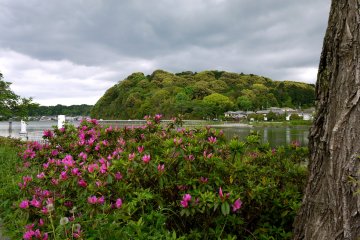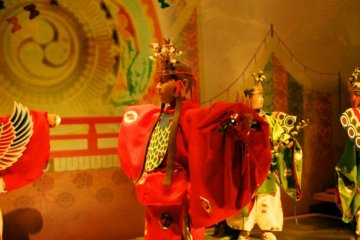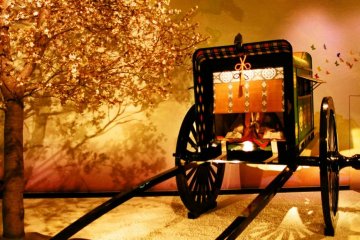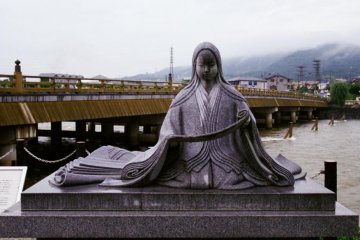Fans of Murasaki Shikibu’s renowned novel ‘The Tale of Genji’ should visit Uji’s excellent museum and immerse themselves in the images and culture of the world’s first novel. Just half an hour by train from Kyoto the city of Uji is famous for its tea and as the setting for the final ten chapters of the book. The chapters are often called ‘Uji-Jujo’ or the ‘Ten Chapters of Uji’ so it is quite fitting that the small city, once a quiet and spiritual retreat for members of the aristocracy, is now home to a museum dedicated to Japan’s most famous literary work.
The museum, just a short walk from Uji station, is filled with models, images and information about the book. The first exhibition area, the Heian Room focuses on the archaic culture in which the story is set. I particularly enjoyed seeing the life-size model gissha, an elaborately lacquered oxen-drawn carriage and examples of the sumptuous twelve layered juni-hitoe kimono worn by court ladies. There is also a scale model of Genji’s Rokujo-In residence allowing you the chance to peek into the private world in which the Shining Prince housed all his favorite ladies.
Next we travel over a bridge evoking the story’s shift from the ancient capital Kyoto to Uji and the same journey made by many nobles of the period. In the next room, the Uji Room, the mood is more sombre as in the Uji chapters. Scenes from the book are recreated with life-size models, sound and atmospheric projections allowing you to feel as if you are walking amongst the characters and experiencing the complex tales for yourself.
The final exhibition area is a small cinema where you can watch a short film specially created for the museum to tell the story of the Uji Chapters' tragic heroine Hashi Hime. English, Chinese and Korean translations are available so that even foreign visitors can enjoy the film and see the world exhibited in the museum come to life.
Aside from the three main rooms the museum offers plenty of information and resources for fans of The Tale of Genji from exhibitions of illustrations relating to the book, a library filled with relevant books and DVDs and interactive screens where you can 'try on' typical clothing from the Heian Period or try your hand at Genji games and quizzes. There is also a shop selling souvenirs and a small cafe that overlooks a pretty Japanese garden and serves tea, coffee and sweets named after characters from the book. Though most of the exhibits are labeled in Japanese the museum has several very useful leaflets and guides in English.









